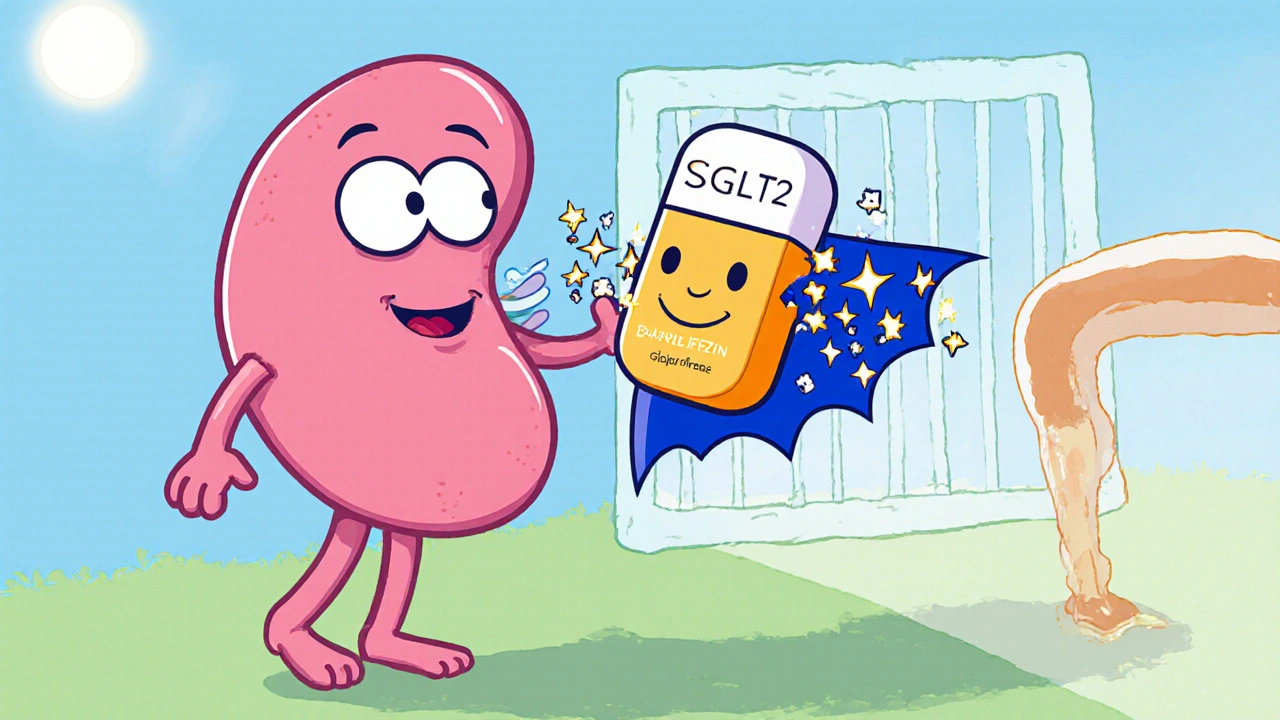Dapagliflozin Benefit Estimator
How This Tool Works
This estimator calculates potential benefits based on clinical trial data. Input your current health metrics to see estimated improvements in glycemic control, cardiovascular protection, and kidney function preservation.
Your Health Metrics
Your Estimated Benefits
Glycemic Control
Estimated A1C reduction
Cardiovascular Protection
Reduced risk of heart failure
Kidney Preservation
Slowed eGFR decline
When doctors prescribe Dapagliflozin, a sodium‑glucose co‑transporter‑2 (SGLT2) inhibitor, they are targeting the kidney’s ability to re‑absorb glucose back into the bloodstream. By blocking that pathway, the drug forces excess sugar out in the urine, which brings down blood glucose levels without the need for insulin spikes.
If you're considering dapagliflozin, here's what you need to know.
Key Takeaways
- Dapagliflozin lowers A1C by 0.5‑0.9% in most patients with type 2 diabetes.
- It also reduces risk of heart failure hospitalization and slows chronic kidney disease progression.
- Common side effects are genital yeast infections, urinary tract infections, and mild dehydration.
- Rare but serious risks include diabetic ketoacidosis and severe low‑blood‑pressure events.
- Not suitable for people with severe kidney impairment, active bladder cancer, or recurrent UTIs.
How Dapagliflozin Works
Dapagliflozin belongs to the SGLT2 inhibitor class. In healthy kidneys, the SGLT2 protein re‑captures about 90% of filtered glucose. By inhibiting this transporter, dapagliflozin lets roughly 60‑80 g of glucose exit the body each day. The resulting calorie loss contributes to modest weight reduction (about 2‑3 kg on average). Because the glucose is expelled in the urine, the drug works independently of insulin, making it useful even when beta‑cell function is waning.
Beyond glucose, the osmotic diuresis improves blood pressure by 3‑5 mmHg and reduces arterial stiffness, which explains many of the cardiovascular and renal benefits seen in large outcome trials.
Main Benefits of Dapagliflozin
The drug’s advantages fall into three broad categories:
- Glycemic control: Clinical studies (e.g., START‑D, DECLARE‑Ti) show average A1C reductions of 0.5‑0.9% when added to metformin.
- Cardiovascular protection: In the DAPA‑HF trial, dapagliflozin cut the combined risk of cardiovascular death or heart‑failure hospitalization by 26% across patients with and without diabetes.
- Kidney preservation: The DAPA‑CKD study reported a 44% slowdown in eGFR decline and a 30% drop in the need for renal replacement therapy.
Patients also notice lower systolic blood pressure, reduced uric acid levels (helpful for gout), and a slight appetite suppression that can aid weight management.
Common Side Effects and How to Manage Them
Because the drug forces sugar into the urinary tract, the most frequent complaints are fungal or bacterial infections:
- Genital yeast infection: More common in women (5-7%) than men (1-2%). Prompt treatment with topical azoles usually clears it in a few days.
- Urinary tract infection (UTI): Symptoms include burning, frequency, and cloudy urine. Encourage patients to stay hydrated and seek antibiotics if symptoms persist beyond 48 hours.
Other mild, reversible effects include:
- Increased urination (osmotic diuresis) - advise drinking enough fluids to prevent dehydration.
- Transient drops in blood pressure - monitor especially in patients on antihypertensives.
- Reduced appetite leading to slight weight loss - beneficial for many, but ensure nutrition is adequate.
Serious, albeit rare, adverse events:
- Diabetic ketoacidosis (DKA): Euglycemic DKA can appear with normal glucose levels. Patients should stop dapagliflozin if they develop nausea, vomiting, or abdominal pain and contact their clinician immediately.
- Acute kidney injury: Usually reversible after stopping the drug and restoring volume.
- Low‑blood‑sugar (hypoglycemia): Mostly when combined with insulin or sulfonylureas; dose adjustment may be required.

Who Should Take Dapagliflozin? (Indications & Contra‑indications)
Approved indications (as of 2025):
- Adults with type 2 diabetes inadequately controlled on diet and exercise, alone or with metformin.
- Heart failure with reduced ejection fraction (HFrEF), regardless of diabetes status.
- Chronic kidney disease (CKD) stage 2-4 with eGFR ≥25 mL/min/1.73 m².
Contra‑indications and cautions:
- eGFR < 25 mL/min/1.73 m² (or < 45 mL/min when used for heart‑failure/CKD indication, per FDA labeling).
- Active bladder cancer - dapagliflozin showed increased recurrence risk in pre‑clinical models.
- Repeated serious UTIs or genital infections.
- Pregnancy or breastfeeding - safety not established.
Drug Interactions & Precautions
Dapagliflozin has a relatively clean interaction profile because it is eliminated mainly via the kidneys (renal excretion) and minimally metabolized by CYP enzymes. Nevertheless, watch for:
- Diuretics: Additive blood‑pressure‑lowering effect; consider lowering diuretic dose.
- Insulin or sulfonylureas: Heightened hypoglycemia risk - reduce dose of the insulin‑secretagogue.
- Rifampin (a strong CYP3A inducer): May modestly lower plasma dapagliflozin levels.
Patients with a history of pancreatitis, severe liver disease, or uncontrolled hypertension should be evaluated carefully before initiating therapy.
Comparing Dapagliflozin with Other SGLT2 Inhibitors
| Attribute | Dapagliflozin | Empagliflozin | Canagliflozin |
|---|---|---|---|
| Typical dose | 10 mg - 10 mg daily | 10 mg - 25 mg daily | 100 mg - 300 mg daily |
| FDA‑approved for heart failure | Yes | Yes | No (heart‑failure indication pending) |
| Renal protective label | eGFR ≥25 mL/min/1.73 m² | eGFR ≥20 mL/min/1.73 m² | eGFR ≥30 mL/min/1.73 m² |
| Risk of amputation (reported) | Low | Very low | Higher - boxed warning in US |
| Weight loss (average) | 2‑3 kg | 2‑4 kg | 1‑2 kg |
The table shows that dapagliflozin offers a balanced profile: solid cardiovascular evidence, a low amputation risk, and a liberal renal‑function threshold. Choice often hinges on patient‑specific factors such as existing heart‑failure status or tolerance to higher doses.

Practical Tips for Clinicians and Patients
- Start at the lowest approved dose and titrate based on A1C, eGFR, and blood‑pressure response.
- Educate patients to recognize early signs of genital infection or ketoacidosis.
- Encourage adequate hydration, especially during hot weather or when exercising.
- Schedule renal function labs every 3‑6 months.
- Document any concomitant diuretic dose adjustments to avoid orthostatic hypotension.
Frequently Asked Questions
Can dapagliflozin cause low blood sugar?
On its own, dapagliflozin rarely causes hypoglycemia because it works independently of insulin. However, when combined with insulin, sulfonylureas, or high‑dose metformin, the risk rises, so dosage tweaks may be needed.
Is it safe to use dapagliflozin if I have chronic kidney disease?
Yes, for eGFR ≥ 25 mL/min/1.73 m² the drug is approved to slow CKD progression. Below that threshold the benefit‑risk ratio becomes unfavorable, and the medication should be stopped.
How quickly does dapagliflozin lower blood sugar?
Glycemic effect begins within 24‑48 hours, with maximal A1C reduction observed after 12‑16 weeks of steady dosing.
Do I need to stop dapagliflozin before surgery?
Most guidelines advise holding the medication 24‑48 hours before major surgery to reduce the risk of ketoacidosis and volume depletion.
Can I take dapagliflozin with other SGLT2 inhibitors?
Combining two SGLT2 inhibitors offers no additional benefit and doubles the side‑effect risk; it is not recommended.
Bottom Line
Dapagliflozin sits at the sweet spot between effective glucose control and added heart‑kidney protection. Its side‑effect profile is manageable for most patients, but clinicians must stay vigilant for infections and rare ketoacidosis. When prescribed appropriately, it can be a game‑changer for people juggling high blood sugar, blood‑pressure concerns, and a rising risk of cardiovascular events.


Rakhi Kasana
October 19, 2025 AT 20:05While dapagliflozin offers impressive cardiac and renal benefits, one must not overlook the subtle tyranny of its side‑effects. The recurring yeast infections feel like a punitive reminder that glucose excretion is a double‑edged sword. Even the occasional orthostatic dizziness can undermine a patient’s confidence in their own body. In my view, the drug’s promise is tempered by a chorus of cautions that demand respect.
Leo Chan
November 10, 2025 AT 19:05Hey, I get where you're coming from, but glancing at the big picture, dapagliflozin really shines for folks juggling high blood sugar and heart issues. The modest weight loss and lower blood pressure are like bonus points on a health‑checklist. Plus, many patients report feeling more energetic once their A1C drops.
Christian Georg
December 2, 2025 AT 19:05Let’s unpack the mechanism a bit more, because understanding why it works can help both clinicians and patients feel more comfortable with the therapy. Dapagliflozin blocks the SGLT2 transporter in the proximal tubule, which means roughly 60‑80 grams of glucose are flushed out in the urine each day, translating to a caloric deficit of about 240‑320 kcal. This osmotic diuresis not only lowers plasma glucose but also contributes to a modest reduction in systolic blood pressure (about 3‑5 mmHg) and improves arterial compliance, factors that collectively reduce cardiovascular strain 😊. Clinically, the DECLARE‑Ti and DAPA‑HF trials have demonstrated a 26% reduction in the composite endpoint of cardiovascular death or heart‑failure hospitalization, which is remarkable for a drug originally designed for glycemic control. On the renal front, DAPA‑CKD showed a 44% slowdown in eGFR decline, underscoring the protective effect on kidney function even in non‑diabetic patients. Side‑effect profiles are generally manageable: genital mycotic infections occur in about 5‑7% of women and 1‑2% of men, but they can be promptly treated with topical azoles. Urinary tract infections are also noted, yet steady hydration and early antibiotic intervention mitigate serious outcomes. A rare but noteworthy risk is euglycemic diabetic ketoacidosis, especially when patients are on low‑carb diets or have reduced insulin reserves; clinicians should educate patients to recognize nausea, abdominal pain, and atypical fatigue as red flags. The drug is contraindicated in severe renal impairment (eGFR < 25 mL/min/1.73 m²) and should be paused before major surgeries to avoid volume depletion and potential ketoacidosis. Drug interactions are minimal, though combined use with loop diuretics may necessitate dose adjustments to prevent hypotension. In practice, starting at 10 mg daily and titrating based on A1C response, eGFR, and blood pressure yields optimal outcomes, while periodic labs every 3‑6 months keep safety in check. Overall, when prescribed judiciously, dapagliflozin serves as a versatile agent that bridges glycemic management, cardioprotection, and renal preservation, making it a valuable addition to the therapeutic arsenal for type 2 diabetes and heart‑failure patients alike.